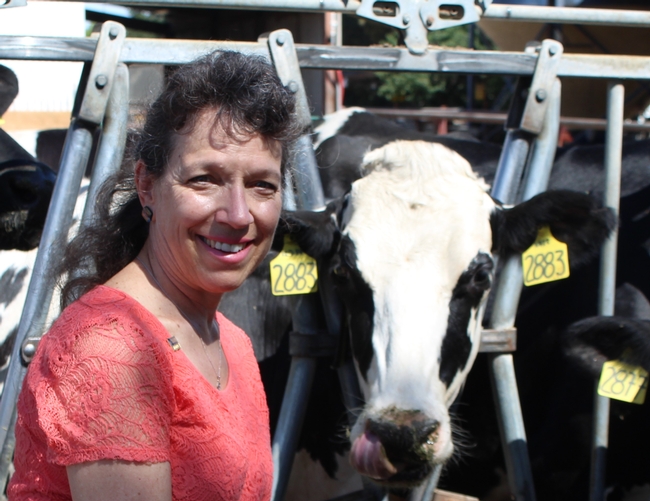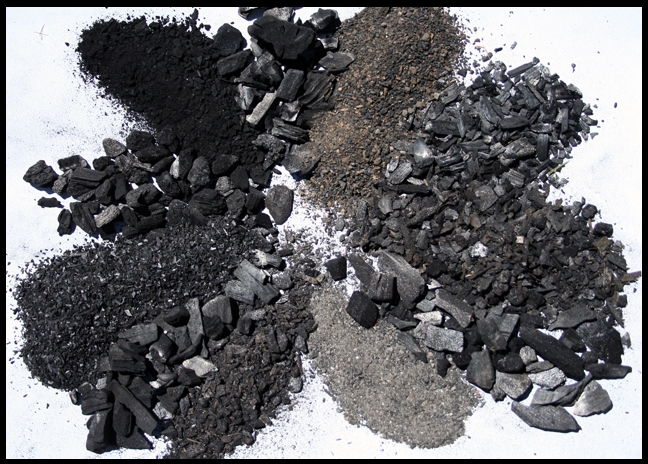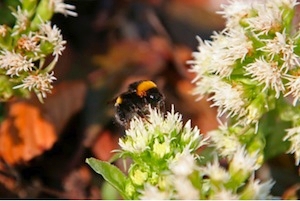Posts Tagged: agricultural sustainability
Meyer receives Bradford-Rominger Agricultural Sustainability Leadership Award
Deanne Meyer, UC Cooperative Extension livestock waste management specialist, is this year's recipient of the Eric Bradford & Charlie Rominger Agricultural Sustainability Leadership Award, given by the Agricultural Sustainability Institute (ASI) at UC Davis.
Meyer is being honored for her leadership in substantially improving the sustainability of California's dairy industry through her research and outreach.
The Bradford-Rominger award recognizes and honors individuals who exhibit the leadership, work ethic and integrity epitomized by the late Eric Bradford, a livestock geneticist who gave 50 years of service to UC Davis, and the late Charlie Rominger, a fifth-generation Yolo County farmer and land preservationist.
Meyer has directed the environmental stewardship efforts of the California Dairy Quality Assurance Program (CDQAP)—a voluntary partnership between the dairy industry, government and academia—since the program's inception in 1996.
Meyer's dedication to build a bridge between industry and regulatory agencies has paid dividends for California's air and water quality. With Meyer's leadership, more than 700 dairy farms have completed an on-site, third-party evaluation of their facility's manure management. The program has been so successful that it received California's highest environmental honor, the Governor's Environmental and Economic Leadership Award, in 2007.
Reflecting on Meyer's work, Glenda Humiston, UC vice president for agriculture and natural resources, said, “Serving as chair of California's Water Quality Task Force in the mid-1990s, I had a front row seat to the challenges Deanne faced as she organized CDQAP and brought many unlikely allies to the table. The many successes of that program is a testament to her skills as both a scientist and a diplomat.”
Beyond Meyer's work with CDQAP, her research in groundwater salinity has provided farmers, agency staff and other concerned stakeholders with unbiased information presented with an understanding of agricultural realities.
“Her efforts, leadership, and dedication are so valued by all the diverse sectors she works across,” said Anita Oberbauer, professor and dean for Agricultural Sciences at UC Davis. “By working closely with regulatory agencies and farmers, she ensures our state's livestock and dairy producers have the tools that they need to meet the environmental challenges.”
Learn more about the Bradford-Rominger award on the Agricultural Sustainability Institute's website.
Past winners of the Bradford-Rominger award include UC Cooperative Extension advisors Rachael Long, Rachel Surls and David Lewis, Sustainable Conservation's Director of Resources Daniel Mountjoy; UCCE advisor Rose Hayden-Smith, UCCE specialist Ken Tate, UCCE advisor Mary Bianchi, natural resource conservation consultant Kelly Garbach and UC Davis lecturer emeritus Isao Fujimoto.
New database captures the benefits of biochar
The origins of interest in biochar, a charcoal-based soil amendment, are almost mythic in nature. In the Amazon Basin, a rainforest region with typically infertile soils, segments of soil have been discovered to be almost black in color and rich in nutrients. The soil’s color is derived from its high organic matter content, believed to originate from historical charcoal applications added to the soil some 2,500 years ago, either intentionally or as a waste product from cooking.
Recently, there has been a growing interest in whether the fertility of these “amazon dark earth soils” can be replicated in modern farming practices, and a new UC Davis database helps users and researchers better understand that replicability.
The charcoal, called biochar when used as a soil amendment, can be derived from nearly any biomass, transforming waste products into this unique additive. Increased bio-fuel production and increased fruit and nut crops in California produce a growing supply of waste that has rich potential as a nutrient. Wood, chicken manure, the residue of corn plants after harvest, and nut shells are all common candidates for biochar, each cooked down in a low- or no-oxygen environment into brittle charcoal and added to soil.
The claims of biochar’s ability to improve soil are vast. Biochar proponents say its addition to soil can increase carbon storage, increase the nutrient and water retention of soils, and reduce the greenhouse gas emissions from soils.
“The basic premise of biochar’s benefit is straightforward,” says Sanjai Parikh, assistant professor of soil chemistry in the Department of Land, Air and Water Resources at UC Davis. “You are putting highly condensed carbon in the soil, so that biochar itself has a longer residence time that just putting a piece of wood, or any raw biomass, in the soil. The fact that biochar is a fairly recalcitrant form of carbon means that microbes cannot utilize it easily as food source and carbon dioxide emissions are thus temporarily reduced. However there is also a lot of excitement around the potential of biochar to also provide a host of specific agronomic benefits.”
But as a relatively young avenue of scientific research, conclusive evidence of its benefits is largely inadequate. To drive forward the understanding of biochar, Parikh, along with postdoctoral scholar Fungai Mukome have created the UC Davis Biochar Database — a forum dedicated to comparing the physical and chemical properties of biochar based on the various sources used to make them, and through that generate a broader understanding of the replicable benefits biochar can bring to soil.
“With our database we’re hoping to provide some of the basic data to the biochar community to link these benefits with specific biochar feedstocks and processing temperatures,” Parikh said.
The database, funded in part by the Agricultural Sustainability Institute at UC Davis, can be used as a resource for biochar researchers, manufacturers and users to better understand the effect that different biochars have shown in soil. Users can begin to tailor their biochar systems to better reflect the advantageous results that have been shown in biochar research. And for those studying the benefits of biochar, the database serves as an open source community that biochar researchers can add to in order to develop a comprehensive guide to the research.
“We released the database with 80 entries, and currently have over 300, but our goal is to grow the database to include 1,000 entries within a year,” Parikh said. “There needs to be a place to come to understand the properties of biochar, and opening the forum for community contributions is an important way to expand our knowledge.”
The biochar database can be visited at biochar.ucdavis.edu and contains instructions on how to download data, and how to contribute to the database by uploading data on biochar chemical and physical properties.
Wild bees get boost from diverse, organic crops
Fields with diversified, organic crops get more buzz from wild bees, concludes a synthesis of 39 studies on 23 crops around the world published March 11 in the journal Ecology Letters.
The study found that wild bees were more abundant in diversified farming systems. Unlike large-scale monoculture agriculture, which typically relies upon pesticides and synthetic fertilizers, diversified farming systems promote ecological interactions that lead to sustainable, productive agriculture. Such systems are characterized by high levels of crop and vegetative diversity in agricultural fields and across farming landscapes.
“The way we manage our farms and agricultural landscapes is important for ensuring production of pollinated-food crops, which provide about one-third of our calories and far higher proportions of critical micronutrients,” said study senior author Claire Kremen, professor at the University of California, Berkeley’s Department of Environmental Science, Policy and Management. “This result provides strong support for the importance of biologically diversified, organic farming systems in ensuring sustainable food systems.”
Many of the study’s authors, including Kremen, also co-authored a study published March 1 in Science that found that fruit and vegetable production increased when wild pollinators – as opposed to domesticated honeybees – were more abundant.
“That study showed that wild bees helped crop yield, and this study shows that organic crops in a diversified farming system help wild bees,” said Kremen.
Christina Kennedy, senior scientist at The Nature Conservancy, is the study’s lead author.
MORE INFORMATION
- Wild Bees Are Good for Crops, But Crops Are Bad For Bees (NPR interview)
- Better Bees: Super Bees and Wild Bees (KQED Quest video)
- Wild bees make honey bees better pollinators (UC Berkeley press release)
Russell Ranch digs deep
Approximately every ten years, the research team at the Russell Ranch Sustainable Agriculture Facility at UC Davis gets the chance to dig deep into their research material to help answer questions about the long-term sustainability of agricultural systems.
With a steel probe attached to the back of a tractor, the team digs three meters deep to take soil samples at 432 different points around the 72-acre field. The initiative takes the team nearly a month to complete, and the information in each soil core can answer major research questions about the long-term effects of different farming methods on soil health and help inform year-round research efforts at the ranch.
“The effort that has gone into collecting this unique set of samples will pay off in figuring out agricultural impacts on processes happening not only in plain sight, but also out of view, buried deep in the soil,” said Russell Ranch director Kate Scow.
The sampling effort is part of the Century Project, Russell Ranch’s 100-year-long experiment. The project divides 72 acres of land into individual one-acre plots, with each plot given different treatments throughout the year. Some plots are irrigated; other plots are farmed without added water. Some plots are treated with compost; others are treated with synthetic fertilizer. Each individual plot demonstrates how a combination of different practices can affect crop yield, soil health and the health of surrounding ecosystems.
The 10-year sampling is a comprehensive look at the system, meant to serve as a baseline in determining the soil health at Russell Ranch. And there are a lot of factors that influence soil health. The research team tests for changes in soil organic matter, organic nitrogen, phosphorous, and other elemental content. They also test for bulk density (the amount of compaction in the soil), moisture content, and the microbial community at different soil depths.
Too, the soil sampling efforts dig deeper in the soil than much research, bringing important new information to soil science.
“Historically, much of the research has focused on the top 15 to 30 centimeters of soil. Some previous ideas about the distribution of carbon in the soil and effects of tillage on soil health have been wrong because of this,” said Scow.
With the Century Project in its 19th year, the 2012 soil samples are the third out of 11 field-wide samples to be taken over the course of the project. Changes to soil can happen slowly, so a long-term focus allows researchers to update their research as new information and new technologies become available.
“The big questions scientists are asking have changed, so we’re hoping to implement a new set of research questions that will drive us for the next 20 years,” said Emma Torbert, post-graduate fellow at Russell Ranch. “The benefit of long-term research is that we are provided the time to respond to those changing questions.”
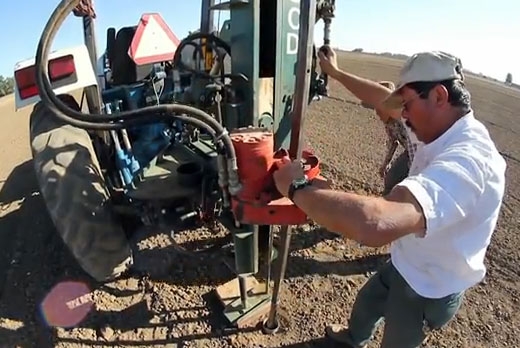
Taking a soil sample at UC Davis' Russell Ranch.
Reinventing agriculture at Russell Ranch
The size, scope and intensity of research at Russell Ranch Sustainable Agriculture Facility at UC Davis make the 300-acre experiment like no other in the world. The ranch’s unique focus on sustainability research is what draws producers, researchers and students to its annual Russell Ranch Sustainable Agriculture Field Day.
Located just west of the main UC Davis campus, Russell Ranch is a testing ground for the long-term sustainability of various farming methods. Research at the ranch focuses on fundamental components of agricultural production – energy, water and land resources – to help address the big questions of the future.
“The human population on the planet is going to increase from about 7 billion people to 9 billion people in 2050, which raises questions about food supply,” said Tom Tomich, director of the Agricultural Sustainability Institute at UC Davis, which houses Russell Ranch. “There is a great success story with agriculture and food production in the last 40 or 50 years – roughly doubling food supply. What that took, though, was doubling of nitrogen, tripling of phosphorus, a lot of advanced research. Now, are we going to be able to do this next doubling to feed the next two billion with business as usual? Or are we are going to have to discover new ways of combining sustainability with intensification to increase productivity?”
A majority of the ranch is comprised of a century-long research project devoted to better understanding the relationships between inputs like fertilizers and cover crops, and various indicators of sustainability. The rest of the ranch hosts a variety of other experiments conducted by researchers not involved in The Century Experiment.
Russell Ranch Field Day
Just as spring gives way to the heat of summer every year Russell Ranch hosts a field day to highlight the research in sustainable farming that is being conducted at UC Davis and primarily at the ranch. This year’s field day focused on issues involving nitrogen, water and climate change.
More than 160 growers, scientists and students learned about greenhouse gas emissions from agriculture, California’s new carbon market and soil microbial communities. Researchers from UC Davis and the company PureSense presented the results of research on a novel method for determining local, crop-specific water demand levels in real time to improve irrigation scheduling.
Thomas Harter, UC Cooperative Extension specialist in the UC Davis Department of Land, Air, and Water Resources, shared the results of a new report, “Addressing Nitrate in California’s Drinking Water,” which is the first comprehensive scientific investigation of nitrate contamination in two of the most agriculturally rich areas of California – the Tulare Lake Basin and the Salinas Valley. Harter and his team found that more than 90 percent of human-generated nitrate contamination of groundwater in these basins is from agricultural activity.
“First and foremost, this is about getting safe drinking water to people,” Harter said.
Problems like these inspire researchers at Russell Ranch to help agriculture develop in a way that will feed the planet’s growing population without creating health and environmental problems, Tomich said.
“California agriculture has always had this spirit of innovation. It has basically reinvented itself every generation. So, a lot of what we’re about here and throughout the Agricultural Sustainability Institute at UC Davis is asking: What’s going to be the scientific foundation for the next generation of California agriculture?”
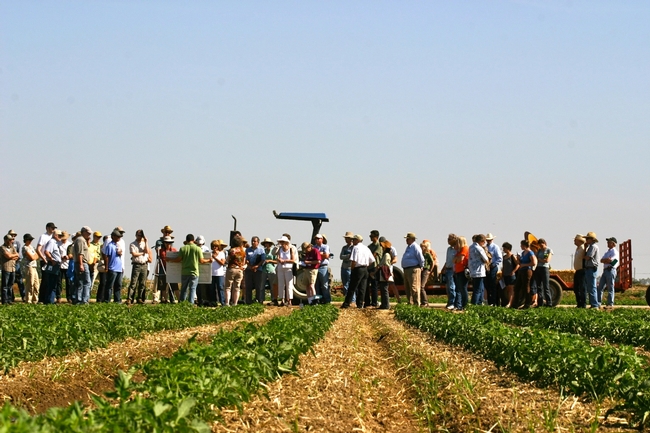
Field day at Russell Ranch.


